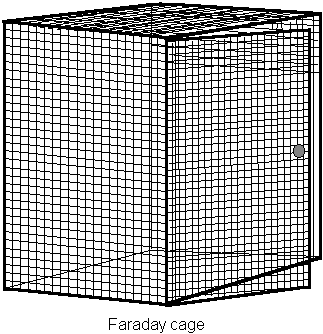Faraday Cage
Contents of a Faraday Cage are shielded from static electrical fields. The term is named after the individual that discovered the property of the structure, Michael Faraday. It is a metal cage that is an electromagnetic shield.
Individuals in amateur radio are interested in the properties of the Faraday Cage.
Individuals that work with electric utilities and AC also are interested in the design from an engineering perspective.
Crazy "cooks" known as "survivalists" and "preppers" are also interested in the protective properties of the Faraday Cage in a misguided belief that it will help them protect their electronics from an EMP pulse attack. They are just crazy.
Possible uses of a Faraday Cage:
- Radio experimentation. Your transmissions can be contained as to not create interference.
- Equipment protection. Equipment within the cage should be shielded from external electromagnetic radiation.
- Personal protection. Protect your body from strong electromagnetic fields by working from within the cage.
- Laboratory use. The size and spacing of the metal and various designs can be studied in relation to RF frequency and strength.
The Faraday Cage is from the principles discussed in Faraday's Law. Electromagnetic induction was discovered by Michael Faraday in 1831. Just a year later Joseph Henry also made the same discovery without any knowledge of Faraday's work. Today we honor these two pioneers with the measurement unit known as the Farad and the Henry. The Farad (F) is the unit measurement of capacitance and the Henry (H) is the unit of measurement of inductance.
Faraday's law
Our understanding of electromagnetism and how it interacts or relates to induction in an electric circuit comes from the work of Michael Faraday. This law states, "The induced electromotive force in any closed circuit is equal to the negative of the time rate of change of the magnetic flux enclosed by the circuit."
This is not an absolute truth, and therefore modification to address real world electric circuits was necessary. The revision is introduced as the Maxwell–Faraday equation. This states, "A time-varying magnetic field is always accompanied by a spatially varying, non-conservative electric field." This law applies both ways. The Maxwell–Faraday equation is one of the four Maxwell's equations, and therefore plays a fundamental role in the theory of classical electromagnetism.
